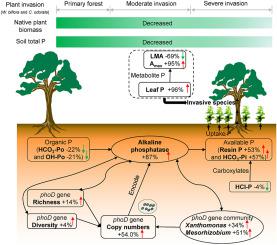当前位置:
X-MOL 学术
›
Soil Biol. Biochem.
›
论文详情
Our official English website, www.x-mol.net, welcomes your feedback! (Note: you will need to create a separate account there.)
Plant invasion alters soil phosphorus cycling on tropical coral islands: Insights from Wollastonia biflora and Chromolaena odorata invasions
Soil Biology and Biochemistry ( IF 9.7 ) Pub Date : 2024-03-25 , DOI: 10.1016/j.soilbio.2024.109412 Xianzhen Luo , Nan Liu , Hans Lambers , Hongyue Cai , Enqing Hou , Yao Huang , Shuguang Jian , Yuanwen Kuang , Dazhi Wen , Lingling Zhang
Soil Biology and Biochemistry ( IF 9.7 ) Pub Date : 2024-03-25 , DOI: 10.1016/j.soilbio.2024.109412 Xianzhen Luo , Nan Liu , Hans Lambers , Hongyue Cai , Enqing Hou , Yao Huang , Shuguang Jian , Yuanwen Kuang , Dazhi Wen , Lingling Zhang

|
Plants may modify soil biogeochemical properties that facilitate their invasion of new sites which may be mediated by soil microorganisms. We compared microbially-mediated soil phosphorus (P) cycling among sites with different degrees of invasion by and on two coral islands. and outcompeted all native species and invested more P in leaves (45–136% more than the native species). We found a decrease in the proportion of HCl–P and organic P, and a corresponding increase in the proportion of labile inorganic P (Pi) of the soil total P concentrations following plant invasion. Leaf P concentrations in invasive species were positively correlated with the proportion of labile Pi, suggesting that HCl–P and organic P were the major P sources for invasive plants, and that plant invasion increased soil P-cycling rates as a result of root carboxylate release (evidenced by greater leaf manganese concentrations) and enhanced soil alkaline phosphatase activity. The latter was confirmed by an increased soil gene abundance after plant invasion. Soil P availability was elevated after plant invasion which was associated with increases in the release of root carboxylates and microbial activities that are involved in mobilization of HCl–P and mineralization of organic P, respectively, especially in the wet season. This, in turn, strongly increased leaf P concentrations of invasive species to sustain rapid plant growth, and presumably depriving competitors of P. These novel insights into soil P cycling through the enrichment of a specific soil microbial community and root carboxylate release in invaded ecosystems enhance our understanding of plant invasion mechanisms on coral islands.
中文翻译:

植物入侵改变了热带珊瑚岛上的土壤磷循环:来自 Wollastonia biflora 和 Chromolaena odorata 入侵的见解
植物可以改变土壤的生物地球化学特性,从而促进它们入侵可能由土壤微生物介导的新地点。我们比较了两个珊瑚岛上不同程度入侵的地点之间微生物介导的土壤磷 (P) 循环。并超越了所有本地物种,并在叶子上投入了更多的磷(比本地物种多 45-136%)。我们发现植物入侵后土壤总磷浓度中HCl-P和有机磷的比例下降,而不稳定无机磷(Pi)的比例相应增加。入侵物种的叶片磷浓度与不稳定磷的比例呈正相关,表明HCl-P和有机磷是入侵植物的主要磷源,并且植物入侵由于根部羧酸盐的释放而增加了土壤磷循环速率(通过更高的叶片锰浓度证明)和增强的土壤碱性磷酸酶活性。植物入侵后土壤基因丰度的增加证实了后者。植物入侵后土壤磷的有效性升高,这与根部羧酸盐释放的增加和微生物活动的增加有关,这些微生物活动分别涉及 HCl-P 的动员和有机磷的矿化,特别是在雨季。这反过来又大大增加了入侵物种的叶片磷浓度,以维持植物的快速生长,并可能剥夺竞争者的磷。这些通过富集特定土壤微生物群落和入侵生态系统中根部羧酸盐释放来增强土壤磷循环的新见解我们对珊瑚岛上植物入侵机制的了解。
更新日期:2024-03-25
中文翻译:

植物入侵改变了热带珊瑚岛上的土壤磷循环:来自 Wollastonia biflora 和 Chromolaena odorata 入侵的见解
植物可以改变土壤的生物地球化学特性,从而促进它们入侵可能由土壤微生物介导的新地点。我们比较了两个珊瑚岛上不同程度入侵的地点之间微生物介导的土壤磷 (P) 循环。并超越了所有本地物种,并在叶子上投入了更多的磷(比本地物种多 45-136%)。我们发现植物入侵后土壤总磷浓度中HCl-P和有机磷的比例下降,而不稳定无机磷(Pi)的比例相应增加。入侵物种的叶片磷浓度与不稳定磷的比例呈正相关,表明HCl-P和有机磷是入侵植物的主要磷源,并且植物入侵由于根部羧酸盐的释放而增加了土壤磷循环速率(通过更高的叶片锰浓度证明)和增强的土壤碱性磷酸酶活性。植物入侵后土壤基因丰度的增加证实了后者。植物入侵后土壤磷的有效性升高,这与根部羧酸盐释放的增加和微生物活动的增加有关,这些微生物活动分别涉及 HCl-P 的动员和有机磷的矿化,特别是在雨季。这反过来又大大增加了入侵物种的叶片磷浓度,以维持植物的快速生长,并可能剥夺竞争者的磷。这些通过富集特定土壤微生物群落和入侵生态系统中根部羧酸盐释放来增强土壤磷循环的新见解我们对珊瑚岛上植物入侵机制的了解。



























 京公网安备 11010802027423号
京公网安备 11010802027423号